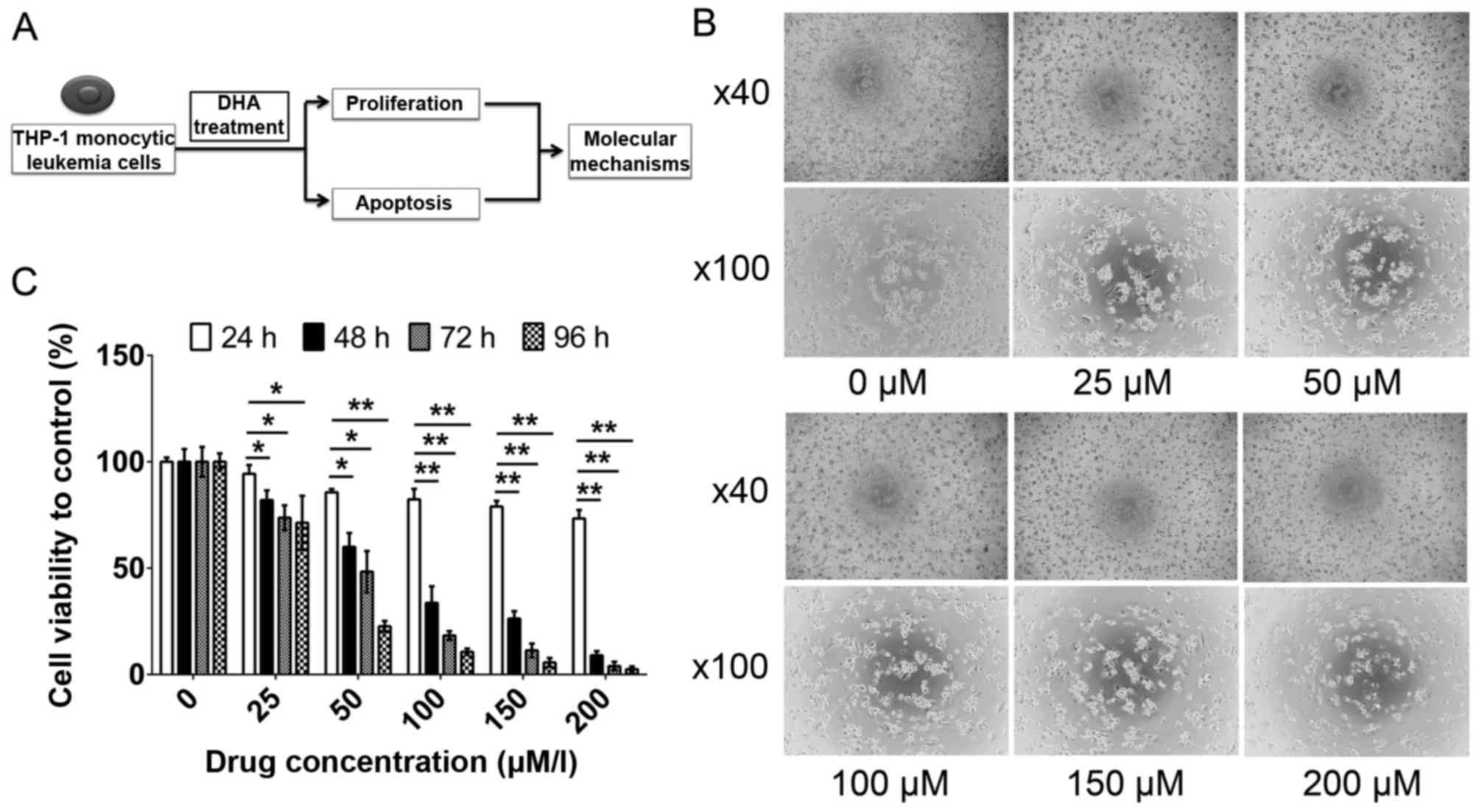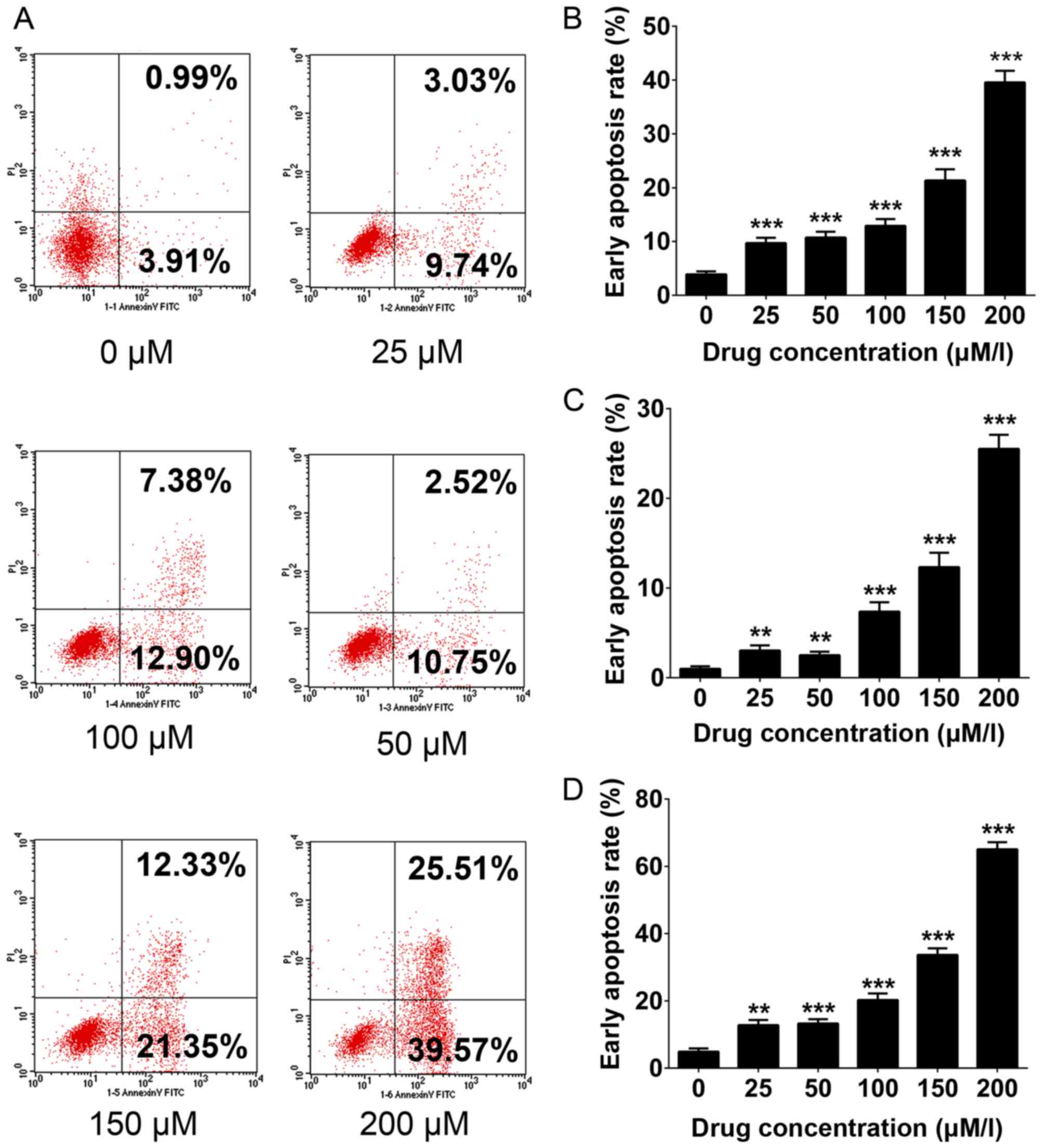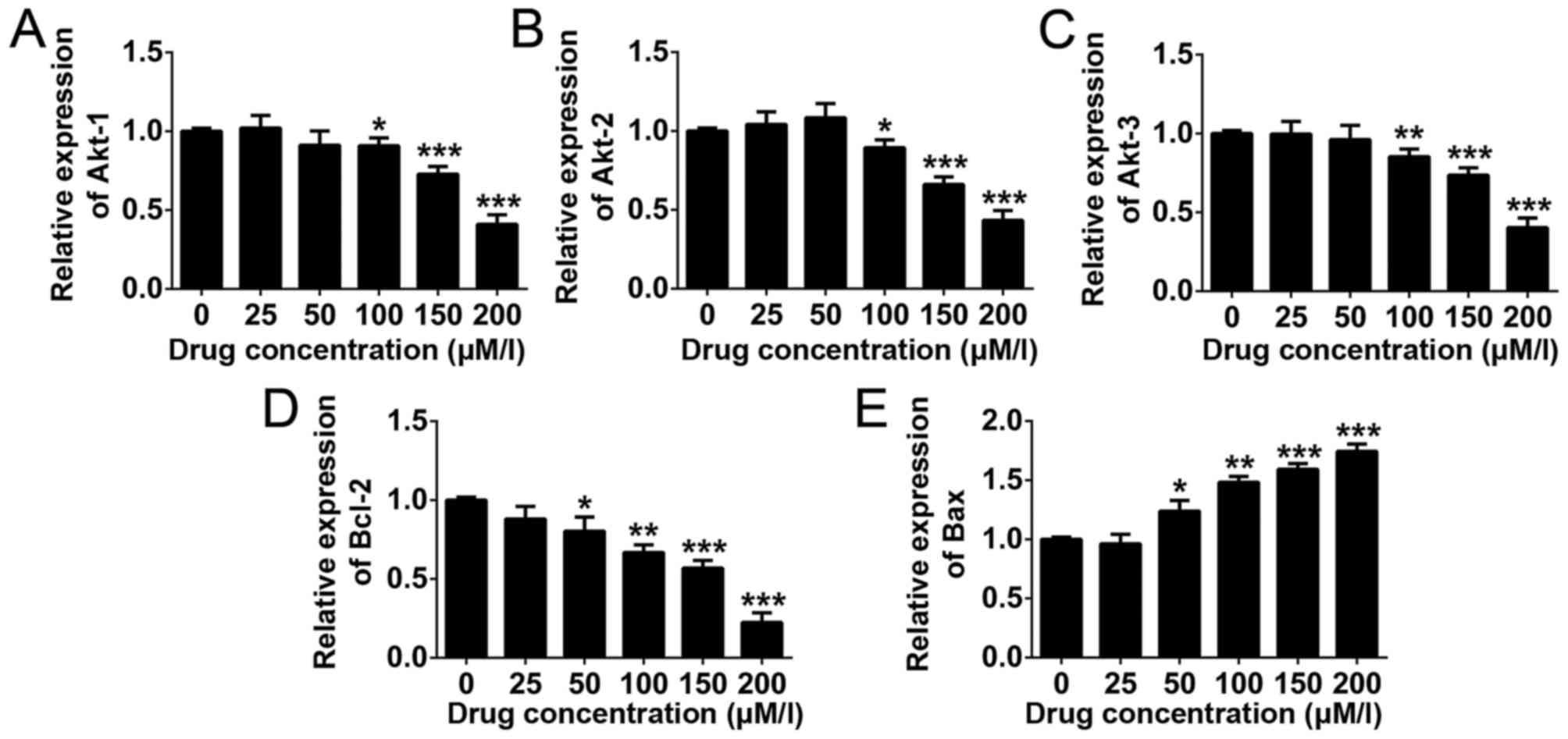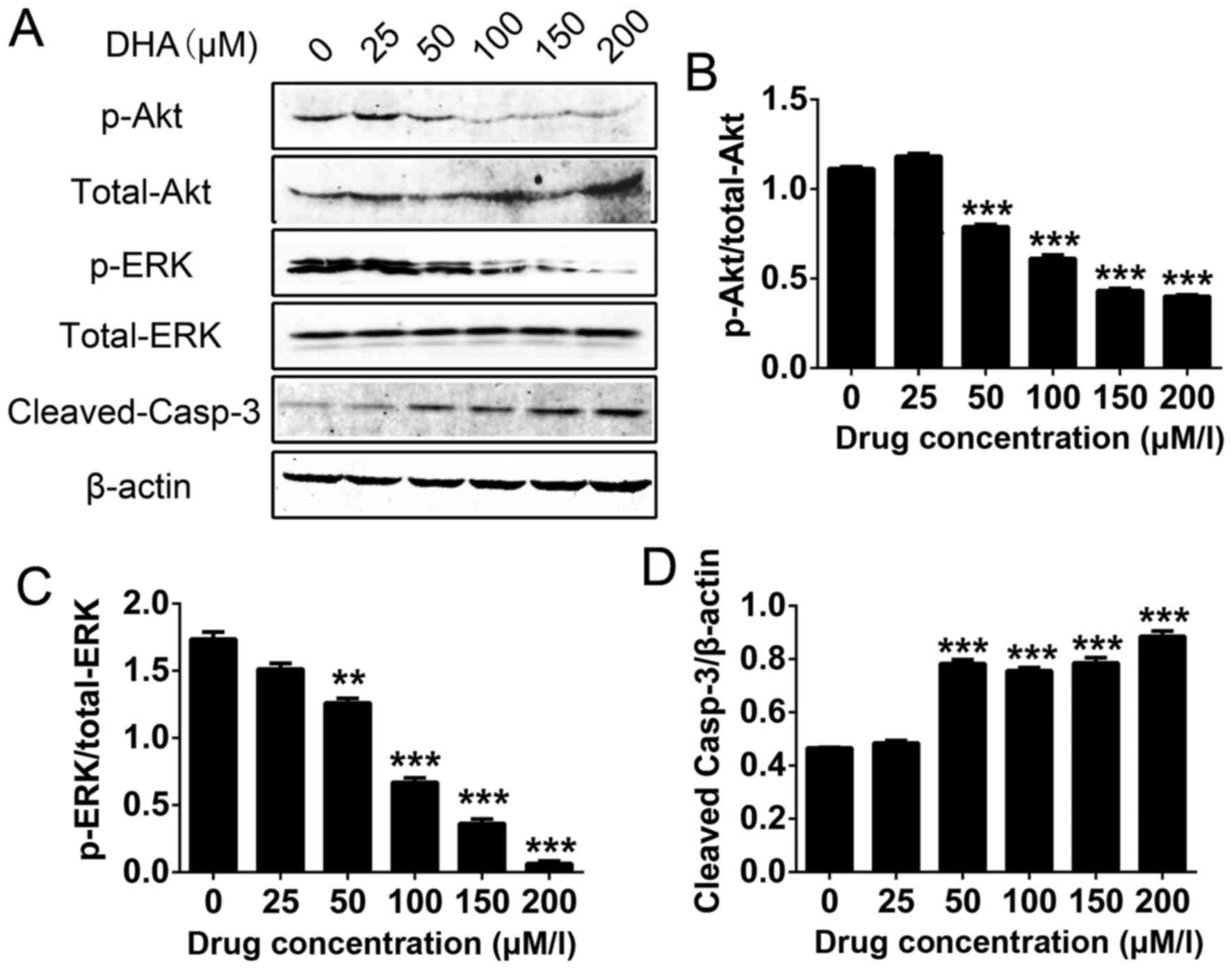Dihydroartemisinin-induced apoptosis in human acute monocytic leukemia cells
- Authors:
- Published online on: December 19, 2017 https://doi.org/10.3892/ol.2017.7644
- Pages: 3178-3184
Abstract
Introduction
Acute myeloid leukemia (AML) is a clonal disorder that comprises a group of clonal malignant diseases, in which the cancer cells originate from the bone marrow and display genetic instability, leading to the accumulation of abnormal immature myeloid cells in the bone marrow and blood (1). The principal therapeutic strategies for patients with AML are aggressive chemotherapeutic regimens and hematopoietic stem cell transplantation (HSCT) (1–3). However, AML consists of 8 subtypes, including M0 (minimally differentiated AML), M1 (AML without maturation), M2 (AML with maturation), M3 (acute promyelocytic leukemia), M4 (acute myelomonocytic leukemia), M5 [acute monocytic leukemia (AMoL)], M6 (erythroleukemia) and M7 (acute megakaryoblastic leukemia). Patients with AML who receive intensive chemotherapy may achieve complete remission; however, the overall survival rate of patients with AML is poor and the treatment is typically associated with serious complications (4). In addition, there is no optimal therapeutic schedule for each type of AMoL (5). Therefore, the aim of the present study was to identify a novel drug for treating M5 (AMoL).
The development of AMoL is a complex, multistep and multifactorial process. Features of M5 typically include increased numbers of white blood cells, an increased rate of marrow infiltration and an increase in chromosomal aberrations including translocation, mutation, aneuploidy and the formation of fusion genes (6,7). Furthermore, the clinical complete remission rate is low with poor prognosis. A total of 87 different translocations have been identified, with 11q23 chromosomal abnormalities accounting for ~22% of M5 cases. There are various chemotherapy regimens used to treat patients with AMoL including: i) Homoharringtonine, cytarabine and etoposide; ii) daunorubicin, Ara-c and teniposide; and iii) mitoxantrone, Ara-c and teniposide (7). However, AMoL is insensitive to a number of chemotherapy regimens, thus patients with AMoL exhibit a low remission rate and decreased survival time (2,6,7). Therefore, novel effective drugs are required.
Since novel antitumor drugs fell under investigation, bioactive natural products have emerged and gained considerable attention. Artemisinin is an effective drug for treating malaria and belongs to the family of sesquiterpene lactones, which are produced by the Artemisia annua plant (8). Dihydroartemisinin (DHA) is a water-soluble semi-synthetic derivative of artemisinin (9), and it is commercially combined with piperaquine as an effective therapy for malaria with limited side effects (10,11). In addition, DHA has been identified to exhibit inhibitory effects on cancer cells, including lung carcinoma (12), osteosarcoma (13) and ovarian cancer (14). Previous studies have demonstrated that DHA may inhibit molt-4 acute lymphoid cell leukemia cells (15,16). However, the effects and underlying mechanisms of action of DHA in AMoL remain unknown.
Therefore, the aim of the present study was to analyze the antitumor effects of DHA against AMoL and to investigate its underlying biological mechanisms. An in vitro approach (Fig. 1A) was used to elucidate the molecular mechanisms underlying these effects of DHA. The results of the present study verified that DHA exhibited effective antitumor activity against AMoL in vitro via the downregulation of phospho-protein kinase B (p-Akt) and p-extracellular signal-regulated kinase (ERK) protein expression, and the upregulation of cleaved caspase-3 levels.
Materials and methods
Reagents and antibodies
The chemical reagents, including DHA, used in the present study were purchased from Sigma-Aldrich (Merck KGaA, Darmstadt, Germany) unless stated otherwise. A stock solution (200 mM) of DHA was prepared in dimethyl sulfoxide (Sigma-Aldrich; Merck KGaA) and stored at −20°C. Primary antibodies against p-ERK (cat. no. 4348S), total (t)-ERK (cat. no. 4695S), p-Akt (cat. no. 4060S), t-Akt (cat. no. 4685S), cleaved caspase-3 (cat. no. 1050S), β-actin (cat. no. 4970S) and secondary antibodies (cat. no. 7074) were purchased from Cell Signaling Technology, Inc. (Danvers, MA, USA).
Cell culture
The THP-1 human acute monocytic leukemia cell line was purchased from the Chinese Academy of Sciences (Shanghai, China). THP-1 cells were cultured in RPMI-1640 (HyClone; GE Healthcare, Logan, UT, USA) supplemented with 10% fetal bovine serum, 100 U/ml penicillin and 100 µg/ml streptomycin (all from HyClone; GE Healthcare) at 37°C in a humidified atmosphere containing 5% CO2. All cells were used within 20 passages.
Cell viability assay
DHA cytotoxicity was determined using a Cell Counting Kit-8 (CCK-8; Dojindo Molecular Technologies, Inc., Kumamoto, Japan), which evaluated the metabolic activity of viable cells. A total of 20,000 cells/well were seeded into 96-well plates in RPMI-1640 medium, which contained 100 nM phorbol 12-myristate 13-acetate to induce adherence as THP-1 cells were suspending cells, and subsequently treated with 0, 25, 50, 100, 150 or 200 µM DHA for 24, 48, 72 and 96 h at 37°C. Following treatment with DHA for 24, 48, 72 and 96 h, the RPMI-1640 medium was removed and the cells were washed with PBS. Subsequently, 100 µl RPMI-1640 medium and 10 µl CCK-8 solution was added to each well and incubated at 37°C for 2.5 h. The optical density (OD) at 450 nm was determined daily for the following 4 days using a microplate reader (BioTek Instruments, Inc., Winooski, VT, USA). All measurements were repeated in triplicate. The cell viability compared with the control group was calculated using the following equation: Cell viability to control (%)=ODdrug-treated group/ODcontrol group.
Apoptosis analysis
Cells were seeded at 1×106 cells/well in 6-well plates and harvested 24 h after treatment with 0, 25, 50, 100, 150 and 200 µM DHA. Cells were centrifuged at 500 × g for 5 min at 4°C and the supernatants were discarded. Subsequently, the cells were resuspended in 1X annexin-binding buffer (BD Biosciences, Franklin Lakes, NJ, USA). Apoptotic cells were determined using annexin V-fluorescein isothiocyanate and propidium iodide staining (BD Biosciences, Franklin Lakes, NJ, USA) and quantified using a flow cytometer (BD Biosciences). FlowJo software (version 7.6.1; FlowJo LLC, Ashland, OR, USA) was used to analyze the rate of apoptosis. The cell proliferation results presented in Fig. 1B and C demonstrate the inhibitory effect of DHA on THP-1 cell proliferation. Therefore, further analysis was used to determine whether DHA is able to induce apoptosis. In Fig. 2A, the lower right quadrant represents early apoptosis, whereas the upper right quadrant represents late apoptosis. The proportion of apoptotic cells identified includes cells in early and late apoptosis.
Reverse transcription-quantitative polymerase chain reaction (RT-qPCR)
THP-1 cells (1×106 cells/well) were seeded at in 6-well plates and harvested following treatment with 0, 25, 50, 100, 150 and 200 µM DHA for 24 h. Cells were centrifuged at 500 × g for 5 min at 4°C and the supernatants were discarded. Total RNA was isolated from THP-1 cells treated with 0, 25, 50, 100, 150 and 200 µM DHA using the AxyPrep™ Multisource Total RNA Miniprep kit (Axygen Scientific, Inc., Union City, CA, USA). Equivalent amounts of RNA were converted into cDNA using the PrimeScript™ RT Reagent kit (Takara Bio, Inc., Otsu, Japan) at 37°C for 15 min and 85°C for 5 sec. cDNA was measured using a Nanodrop 2000 instrument (Thermo Fisher Scientific, Waltham, MA, USA). qPCR was performed using an ABI 7500 Sequencing Detection System and SYBR® Premix Ex Taq (Takara Bio, Inc.). All procedures were performed according to the manufacturers' protocols. Cycling conditions included 40 cycles of 95°C for 5 sec and 60°C for 34 sec. Gene expression was quantified using the 2−∆∆Cq method (17). β-actin was used as the reference gene and all primer sequences are listed in Table I.
Western blot analysis
THP-1 cells were analyzed using qPCR and cells were lysed in lysis buffer containing complete EDTA-free tablets which are a protease inhibitor cocktail containing phenylmethylsulfonyl fluoride, aprotinin, bestatin, E-64, leupeptin and pepstatin A (Roche Applied Science, Penzbery, Germany). The protein concentration was quantified using the bicinchoninic acid protein assay kit (Santa Cruz Biotechnology, Inc., Dallas, TX, USA). For western blot analysis, 20 µg total protein were boiled and subsequently separated by SDS-PAGE using a 10% gel for p-Akt, total (t-) Akt, p-ERK, t-ERK and β-actin and a 12.5% gel for cleaved caspase-3. Following electrophoresis, proteins were blotted onto polyvinylidene difluoride membranes and blocked by 5% skimmed milk suspended in Tris-buffered saline with Tween-20 for 1 h at room temperature. Each membrane was incubated with appropriate primary antibodies against p-Akt, t-Akt, p-ERK, t-ERK, cleaved caspase-3 and β-actin, with a dilution ratio of 1:1,000 at 4°C overnight. Blots were subsequently incubated with a horseradish peroxidase-conjugated secondary antibody for 1 h at room temperature. Protein bands were visualized using X-ray films and an enhanced chemiluminescence detection system (GE Healthcare Life Sciences, Little Chalfont, UK). Positive immunoreactive bands were densitometrically quantified and normalized to β-actin. Adobe Photoshop (Creative Suite 5; Adobe Systems, Inc., San Jose, CA, USA) was used for densitometry.
Statistical analysis
SPSS software (version 19.0; IBM Corp., Armonk, NY, USA) was used to analyze the data. The differences between the experimental groups and controls were assessed using the Student's t-test or one-way analysis of variance as appropriate. The data are expressed as the mean ± standard deviation. All data were obtained from at least three independent experiments. P<0.05 was considered to indicate a statistically significant difference.
Results
THP-1 cell viability decreases following DHA treatment
To investigate the effects of DHA, a cell viability assay using CCK-8 was performed on THP-1 cells. The viability of THP-1 cells was inhibited following treatment with DHA, accompanied by the appearance of morphological characteristics of apoptosis (Fig. 1B). The inhibitory effect of DHA on the viability of THP-1 cells was markedly increased at higher DHA concentrations following 96 h of treatment (P<0.05; Fig. 1C). DHA may inhibit the proliferation of THP-1 cells in a dose- and time-dependent manner.
DHA induces the apoptosis of THP-1 cells
As presented in Fig. 2, flow cytometry analysis was used to evaluate DHA-induced apoptosis. DHA significantly increased the total apoptosis rate (4.9 control vs. 12.77, 13.24, 20.28, 33.68 and 65.08% when treated with 25, 50, 100, 150 and 200 µM DHA, respectively; P<0.05; Fig. 2A and D), and quantitative data regarding the early and late apoptosis rate were consistent with this (Fig. 2B and C). The results of the present study validated the inhibitory function of DHA functioned via the activation of the apoptosis pathway in THP-1 cells.
Downstream gene expression
To investigate the molecular mechanisms underlying the inhibitory effects of DHA in THP-1 human monocytic leukemia cells, RT-qPCR was used to examine variations in gene expression. It was demonstrated that the gene expression levels of Akt1, Akt2, Akt3 and B-cell lymphoma 2 (Bcl-2) were decreased in DHA-treated THP-1 cells in a dose-dependent manner, whereas the expression of Bcl-2-associated X protein (Bax) was upregulated (Fig. 3). The results indicated that these genes are potential downstream targets of DHA in monocytic leukemia treatment.
Akt, ERK and cleaved caspase-3 are potential downstream targets of DHA
Western blot analysis was used to determine the protein expression levels of phospho (p)-Akt/total-Akt, p-ERK/total-ERK and cleaved caspase-3 in THP-1 cells, following different concentrations of DHA treatment. The results revealed that the levels of p-Akt and p-ERK with increasing concentrations of DHA (Fig. 4A-C). However, DHA increased the levels of cleaved caspase-3 in a dose-dependent manner (Fig. 4A and D). Therefore, the results suggested that Akt, ERK and cleaved caspase-3 are potential downstream targets of DHA-induced apoptosis in THP-1 cells.
Discussion
Induction failure and a high incidence of relapse due to drug resistance are the principal problems surrounding AML treatment (2,18). The use of novel drugs is one approach for treating patients who are resistant to standard therapies (19). Clinical evaluation of potentially effective drugs is essential to cancer chemotherapy, and may improve the prognosis of patients with refractory leukemia (20). AMoL is a rare but distinct disease, the increasing number of monocytes throughout its clinical course characterizes the disease, and cytogenetic characterization is required for diagnosis and prognosis stratification (21,22). Thus, there is a requirement to identify less toxic and more efficacious treatment alternatives. As a result, increasing attention has been focused on the application of natural products in the treatment of AMoL (3).
DHA, one of the bioactive derivatives of artemisinin, has been investigated for the treatment of certain tumor types; Professor Tu YouYou, who discovered DHA, was awarded the Nobel Prize in 2015 (23,24). A number of additional pharmacological effects of DHA have been identified, including antitumor activity towards hepatocellular carcinoma in vitro and in vivo (25). Furthermore, DHA was identified to prevent breast cancer-induced osteolysis via inhibiting breast cancer cells and osteoclasts (26). For leukemia treatment, DHA can induce autophagy and inhibit the growth of iron-loaded human myeloid leukemia K562 cells via reactive oxygen species toxicity (27); DHA and its derivative induce apoptosis in acute myeloid leukemia cells through the Noxa-mediated pathway, requiring iron and an endoperoxide moiety (28). However, the effect of DHA on AMoL has yet to be fully elucidated.
The aim of the present study was to investigate whether DHA had antitumor activity against human AMoL. It was identified that DHA has a strong anti-leukemia effect in the THP-1 AMoL cell line in vitro. The results indicated that DHA inhibited the spontaneous growth of THP-1 cells in a time- and dose-dependent manner. To further investigate the mechanisms of DHA anti-leukemia activity, the effect of DHA was analyzed with regards to apoptosis and the activation of Akt/ERK survival signaling and Bcl-2/Bax/caspase-3 apoptosis pathways that are constitutively expressed in THP-1 cells. Results of the present study indicated that DHA-induced apoptosis was caused by downregulating Akt/ERK signaling and activating the caspase-3 pathway, following the balance of the Bcl-2/Bax axis.
Distinct from normal cells, leukemia cells often express constitutively active survival-signaling pathways, such as Akt and ERK among others, due to gene mutations, rearrangements and chromosomal translocations; these survival signaling pathways serve vital roles in tumorigenesis, proliferation, anti-apoptosis and drug resistance (29–31). The higher the number of constitutively active growth signaling pathways in acute myelogenous leukemia, the poorer the prognosis. Results indicated that, in the acute monoblastic leukemia cell line THP-1, the Akt and ERK signal transduction pathways were suppressed simultaneously, and that the caspase-3 apoptosis signaling pathway was activated by the downregulation of the Bcl-2/Bax ratio following DHA treatment. It was speculated that DHA-mediated inhibition of Akt/ERK pathway activation and the promotion of caspase-3 activation would result in a more effective response to anti-leukemia therapy, as the inhibitors would simultaneously target three pathways in THP-1 cells.
A number of specific inhibitors target a single signaling molecule in the treatment of leukemia; however, DHA may be more effective compared with common inhibitors as drug resistance frequently emerges following the hyperactivation of alternative signaling pathways under treatment of a single target. It is predicted that DHA-resistance in AMoL may rarely occur, the response to DHA may be increased and response duration may be longer as DHA exhibited multi-targeting characteristics. Inhibition of multiple signaling pathways increases the therapeutic ability of DHA.
In the present study, the role of DHA in restricting the proliferation and inducing apoptosis in AMoL cells was investigated. DHA may directly or indirectly affect the activation of Akt/ERK survival signaling and caspase-3 apoptosis signaling pathways, all of which are key regulators of cell survival and apoptosis, particularly during AMoL treatment (32,33). However, additional in-depth investigations must follow this preliminary study. First, the intermediate molecular mechanisms underlying DHA-mediated changes to cell survival and apoptosis signaling pathways must be clarified. Secondly, in vivo experiments must be carried out to verify the treatment effects of DHA. Finally, the results must be validated through clinical trials and applications.
In conclusion, the present study indicated that DHA exerted effective antitumor activities against AMoL in vitro. Furthermore, DHA downregulated the expression of p-Akt and p-ERK, whilst also upregulating the protein expression of cleaved caspase-3 through increasing the Bcl-2/Bax ratio. This may be one mechanism by which DHA exerts its effects in AMoL. However, further and more comprehensive studies are required to confirm this.
Acknowledgements
The present study was supported by grants from the Shanghai Health Development Planning Commission (grant no. ZY3-CCCX-3-3006), the National Natural Science Foundation of China (grant nos. 81500392 and 31201010), the Shanghai Committee of Science and Technology of China (grant nos. 12ZR1419500 and 114119a8700) and the Shanghai Health Bureau (grant no. ZYSNXD-CCZDYJ029).
References
|
Ommen HB: Monitoring minimal residual disease in acute myeloid leukaemia: A review of the current evolving strategies. Ther Adv Hematol. 7:3–16. 2016. View Article : Google Scholar : PubMed/NCBI | |
|
Peng H, Wang H, Xue P, Hou Y, Dong J, Zhou T, Qu W, Peng S, Li J, Carmichael PL, et al: Suppression of NRF2-ARE activity sensitizes chemotherapeutic agent-induced cytotoxicity in human acute monocytic leukemia cells. Toxicol Appl Pharmacol. 292:1–7. 2016. View Article : Google Scholar : PubMed/NCBI | |
|
Guo Y, Shan Q, Gong Y, Lin J, Shi F, Shi R and Yang X: Curcumin induces apoptosis via simultaneously targeting AKT/mTOR and RAF/MEK/ERK survival signaling pathways in human leukemia THP-1 cells. Pharmazie. 69:229–233. 2014.PubMed/NCBI | |
|
Ozpolat B, Akar U, Steiner M, Zorrilla-Calancha I, Tirado-Gomez M, Colburn N, Danilenko M, Kornblau S and Berestein GL: Programmed cell death-4 tumor suppressor protein contributes to retinoic acid-induced terminal granulocytic differentiation of human myeloid leukemia cells. Mol Cancer Res. 5:95–108. 2007. View Article : Google Scholar : PubMed/NCBI | |
|
Murashige N, Tabanda R and Zalusky R: Occurrence of acute monocytic leukemia in a case of untreated Waldenstrom's macroglobulinemia. Am J Hematol. 71:94–97. 2002. View Article : Google Scholar : PubMed/NCBI | |
|
Cline MJ: Histiocytes and histiocytosis. Blood. 84:2840–2853. 1994.PubMed/NCBI | |
|
Kumar RK, Basu S, Lemke HD, Jankowski J, Kratz K, Lendlein A and Tetali SD: Effect of extracts of poly(ether imide) microparticles on cytotoxicity, ROS generation and proinflammatory effects on human monocytic (THP-1) cells. Clin Hemorheol Microcirc. 61:667–680. 2016. View Article : Google Scholar : PubMed/NCBI | |
|
Li Y: Qinghaosu (artemisinin): Chemistry and pharmacology. Acta Pharmacol Sin. 33:1141–1146. 2012. View Article : Google Scholar : PubMed/NCBI | |
|
Lin AJ, Klayman DL and Milhous WK: Antimalarial activity of new water-soluble dihydroartemisinin derivatives. J Med Chem. 30:2147–2150. 1987. View Article : Google Scholar : PubMed/NCBI | |
|
Ashley EA, McGready R, Hutagalung R, Phaiphun L, Slight T, Proux S, Thwai KL, Barends M, Looareesuwan S, White NJ and Nosten F: A randomized, controlled study of a simple, once-daily regimen of dihydroartemisinin-piperaquine for the treatment of uncomplicated, multidrug-resistant falciparum malaria. Clin Infect Dis. 41:425–432. 2005. View Article : Google Scholar : PubMed/NCBI | |
|
Gordi T and Lepist EI: Artemisinin derivatives: Toxic for laboratory animals, safe for humans? Toxicol Lett. 147:99–107. 2004. View Article : Google Scholar : PubMed/NCBI | |
|
Mi YJ, Geng GJ, Zou ZZ, Gao J, Luo XY, Liu Y, Li N, Li CL, Chen YQ, Yu XY and Jiang J: Dihydroartemisinin inhibits glucose uptake and cooperates with glycolysis inhibitor to induce apoptosis in non-small cell lung carcinoma cells. PLoS One. 10:e01204262015. View Article : Google Scholar : PubMed/NCBI | |
|
Liu W, Wang DW, Yu SY, Cao Y, Yang L, E XQ, Yao GJ and Bi ZG: The effect of dihydroartemisinin on the proliferation, metastasis and apoptosis of human osteosarcoma cells and its mechanism. J Biol Regul Homeost Agents. 29:335–342. 2015.PubMed/NCBI | |
|
Feng X, Li L, Jiang H, Jiang K, Jin Y and Zheng J: Dihydroartemisinin potentiates the anticancer effect of cisplatin via mTOR inhibition in cisplatin-resistant ovarian cancer cells: Involvement of apoptosis and autophagy. Biochem Biophys Res Commun. 444:376–381. 2014. View Article : Google Scholar : PubMed/NCBI | |
|
Park J, Lai HC, Singh M, Sasaki T and Singh NP: Development of a dihydroartemisinin-resistant Molt-4 leukemia cell line. Anticancer Res. 34:2807–2810. 2014.PubMed/NCBI | |
|
Chan HW, Singh NP and Lai HC: Cytotoxicity of dihydroartemisinin toward Molt-4 cells attenuated by N-tert-butyl-alpha-phenylnitrone and deferoxamine. Anticancer Res. 33:4389–4393. 2013.PubMed/NCBI | |
|
Schmittgen TD and Livak KJ: Analyzing real-time PCR data by the comparative C(T) method. Nat Protoc. 3:1101–1108. 2008. View Article : Google Scholar : PubMed/NCBI | |
|
Zhang D, Wang Q, Zhu T, Cao J, Zhang X, Wang J, Wang X, Li Y, Shen B and Zhang J: RACK1 promotes the proliferation of THP1 acute myeloid leukemia cells. Mol Cell Biochem. 384:197–202. 2013. View Article : Google Scholar : PubMed/NCBI | |
|
Zeng C, Wang W, Yu X, Yang L, Chen S and Li Y: Pathways related to PMA-differentiated THP1 human monocytic leukemia cells revealed by RNA-Seq. Sci China Life Sci. 58:1282–1287. 2015. View Article : Google Scholar : PubMed/NCBI | |
|
Evans FJ and Hilton JH: Polymyositis associated with acute Nonocytic leukemia: Case report and review of the literature. Can Med Assoc J. 91:1272–1275. 1964.PubMed/NCBI | |
|
Wang Y, Ma L, Wang C, Sheng G, Feng L and Yin C: Autocrine motility factor receptor promotes the proliferation of human acute monocytic leukemia THP-1 cells. Int J Mol Med. 36:627–632. 2015. View Article : Google Scholar : PubMed/NCBI | |
|
Jain SK, Sahu R, Walker LA and Tekwani BL: A parasite rescue and transformation assay for antileishmanial screening against intracellular Leishmania donovani amastigotes in THP1 human acute monocytic leukemia cell line. Journal of visualized experiments. 70:e40542012. | |
|
Tu YY: TU You-you won Lasker Debakey clinical medical research award-for her outstanding achievements in studies on artemisinin. Zhongguo Zhong Xi Yi Jie He Za Zhi. 31:13012011.(In Chinese). PubMed/NCBI | |
|
Dong YJ, Li WD and Tu YY: Effect of dihydro-qinghaosu on auto-antibody production, TNF alpha secretion and pathologic change of lupus nephritis in BXSB mice. Zhongguo Zhong Xi Yi Jie He Za Zhi. 23:676–679. 2003.(In Chinese). PubMed/NCBI | |
|
Zhang CZ, Zhang H, Yun J, Chen GG and Lai PB: Dihydroartemisinin exhibits antitumor activity toward hepatocellular carcinoma in vitro and in vivo. Biochem Pharmacol. 83:1278–1289. 2012. View Article : Google Scholar : PubMed/NCBI | |
|
Feng MX, Hong JX, Wang Q, Fan YY, Yuan CT, Lei XH, Zhu M, Qin A, Chen HX and Hong D: Dihydroartemisinin prevents breast cancer-induced osteolysis via inhibiting both breast cancer cells and osteoclasts. Sci Rep. 6:190742016. View Article : Google Scholar : PubMed/NCBI | |
|
Wang Z, Hu W, Zhang JL, Wu XH and Zhou HJ: Dihydroartemisinin induces autophagy and inhibits the growth of iron-loaded human myeloid leukemia K562 cells via ROS toxicity. FEBS Open Bio. 2:103–112. 2012. View Article : Google Scholar : PubMed/NCBI | |
|
Zhao X, Zhong H, Wang R, Liu D, Waxman S, Zhao L and Jing Y: Dihydroartemisinin and its derivative induce apoptosis in acute myeloid leukemia through Noxa-mediated pathway requiring iron and endoperoxide moiety. Oncotarget. 6:5582–5596. 2015.PubMed/NCBI | |
|
Lim SG, Suk K and Lee WH: Reverse signaling from LIGHT promotes pro-inflammatory responses in the human monocytic leukemia cell line, THP-1. Cell Immunol. 285:10–17. 2013. View Article : Google Scholar : PubMed/NCBI | |
|
Teng CL, Han SM, Wu WC, Hsueh CM, Tsai JR, Hwang WL and Hsu SL: Mechanistic aspects of lauryl gallate-induced differentiation and apoptosis in human acute myeloid leukemia cells. Food Chem Toxicol. 71:197–206. 2014. View Article : Google Scholar : PubMed/NCBI | |
|
Shi D, Xu Y, Du X, Chen X, Zhang X, Lou J, Li M and Zhuo J: Co-treatment of THP-1 cells with naringenin and curcumin induces cell cycle arrest and apoptosis via numerous pathways. Mol Med Rep. 12:8223–8228. 2015. View Article : Google Scholar : PubMed/NCBI | |
|
Olesen LH, Aggerholm A, Andersen BL, Nyvold CG, Guldberg P, Nørgaard JM and Hokland P: Molecular typing of adult acute myeloid leukaemia: Significance of translocations, tandem duplications, methylation, and selective gene expression profiling. Br J Haematol. 131:457–467. 2005. View Article : Google Scholar : PubMed/NCBI | |
|
Ruvolo PP, Qiu Y, Coombes KR, Zhang N, Neeley ES, Ruvolo VR, Hail N Jr, Borthakur G, Konopleva M, Andreeff M and Kornblau SM: Phosphorylation of GSK3α/β correlates with activation of AKT and is prognostic for poor overall survival in acute myeloid leukemia patients. BBA Clin. 4:59–68. 2015. View Article : Google Scholar : PubMed/NCBI |













